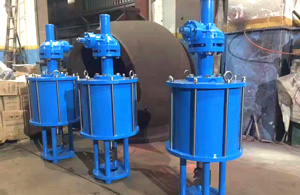
When the compressed air enters the pneumatic actuator from the a nozzle, the gas pushes the double pistons to move in a straight line towards both ends (cylinder head end). The rack on the piston drives the gear on the rotating shaft to rotate 90 degrees anticlockwise, and the valve is opened. At this time, the gas at both ends of the pneumatic actuator valve is discharged with the B nozzle. On the contrary, when the compressed air enters the two ends of the pneumatic actuator from the B nozzle, the gas pushes the double plug to move straight to the middle, the rack on the piston drives the gear on the rotating shaft to rotate 90 degrees clockwise, and the valve is closed. At this time, the gas in the middle of the pneumatic actuator is discharged with the a nozzle. The above is the transmission principle of standard type. According to the user's requirements, the pneumatic actuator can be installed in the opposite transmission principle of the standard type, that is, select the clockwise rotation of the shaft to open the valve, and the counterclockwise rotation to close the valve. Nozzle a of single acting (spring return type) pneumatic actuator is air inlet, and nozzle B is exhaust port (muffler shall be installed for nozzle b). The air inlet of nozzle a is to open the valve. When the air is cut off, the valve is closed by spring force.

